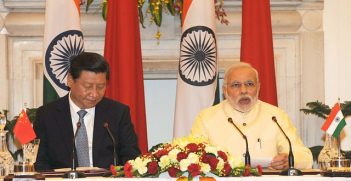Most Read of 2020: Border Disputes Between India and Nepal: Will India Act as a Responsible Rising Power?

India and Nepal’s enduring border disputes have repeatedly provoked nationalist movements and protests in Nepal and alienated Nepal from India. Resolving the disputes through cooperative rather than coercive measures will be critical for India’s ambition to become a “responsible” rising power.
This article was one of the most read in Australian Outlook in 2020.
Protracted border disputes have routinely soured bilateral relations between India and Nepal. The two countries share an approximately 1800 kilometer international open border, which is managed under the bilateral Treaty of Peace and Friendship (1950). The border had been agreed upon in the 1816 Treaty of Sugauli, which states in Article 5 that Nepal “renounces for himself, his heirs, and successors, all claim to or connection with the countries lying to the west of the River Kali.” This means the Kalapani to Limpiyadhura stretch east of the Kali river historically belongs to Nepal. However, India has deliberately misinterpreted the origin of the Kali River to claim Nepal’s lands in the Kalapani–Limpiyadhura region, including the Lipu Lekh region. To resolve the dispute, Nepal and India formed a Joint Technical Committee (JTC) in 1981, which was successful in resolving 97 percent of the border issues. The remaining three percent, approximately 606 square kilometers of disputed area, is the crux of the protracted border disputes.
The border tension re-escalated on 8 May 2020 when Indian Defense Minister Rajnath Singh inaugurated the 80 kilometer-long road to Mansarobar, a part of which is built on Nepal’s land in Lipu Lekh area. In response to Nepal’s blatant objection to the unilateral construction of the road, the Indian external ministry swiftly claimed that it is built “completely within the territory” of India. India’s army chief baselessly complicated the matter, alleging that Nepal’s objection was at China’s behest. In the absence of constructive dialogue, this kind of allegation only deepens the diplomatic crisis and validates Nepal’s allegation that India has failed to respect the Treaty of Peace and Friendship. The Lipu Lekh region is strategically important for connectivity between India and China and the road has long been a desire of the Indian military.
India is a rising global power. However, its track record of dealing with neighbors has been mostly hegemonic. Former National Security Advisor Shivshankar Menon asserts that for India to rise, it should focus on strategic autonomy, characterised by “strengthening itself, consolidating its periphery and external balancing.” However, in practice, external balancing is often marred by India’s coercive and hegemonic foreign policy in South Asia, underpinned by realist ideologies and the distraction from the neighbour-friendly Gujral doctrine. More recently, security and populist-nationalist ideologies and narratives have profoundly reshaped India’s bilateral relations with its neighbours, which helps explain why border disputes between Nepal and India have re-escalated.
From a security viewpoint, China’s growing military and economic power is a prime source of political, bureaucratic, and military anxiety in India. This anxiety, often provocatively amplified by the Indian media, determines how bilateral issues are hijacked by reactive security and strategic narratives. In this context, the hangover of Indo-China war in 1962, when border disputes in Kalapani–Limpiyadhura date back to, has not withered away in the Indian military and political circles. Between 1952 and 1969, India operated 18 military check-posts on Nepal’s western frontier, including one in the Kalapani-Limpiyadhura region, to contain Chinese military threats. Later, Nepal government’s vehement opposition pushed India to remove all check-posts, except the one in Kalapani. The Kalapani post’s strategic location has prevented India from moving the check-post to the Indian side on the west bank of the Kali river.
As the rise of China shifts political order in South Asia, India seems keen to cooperate with rather than confront China. In 2015, India and China had a bilateral understanding to strengthen trade and connectivity through the Nepali territory, Lipu Lekh, in blatant violation of Nepal’s sovereignty. Nepal’s parliament objected the agreement, but was dwarfed by its two gigantic neighbours who turned equally hegemonic on the border issue.
From a populist-nationalist viewpoint, India’s right-wing Bharatiya Janata Party (BJP) government, in power since 2014, has survived with its ideology of Hindu religiosity. To put this into perspective, India’s construction of the road through Nepal creates a shorter, more comfortable, and less costly route for the, Kailash-Mansarovar yatra pilgrimage that any Hindu devotee would dream of making. This makes the road a populist-nationalist project that appeals to the BJP’s Hindu voter base.
In principle, the Indian authorities do not deny dialogue on bilateral issues, but they have repeatedly taken punitive actions to expresses dissatisfaction with Nepal. For instance, in 2015, India unilaterally blocked Nepal’s border over its dissatisfaction with Nepal’s newly promulgated constitution. For survival, Nepal chose to deepen its ties with China. This has added to the anxiety in New Delhi, which had not only alienated one of its historical allies but also created a condition for China’s expansion in the Himalayan nation.
This kind of diplomatic misunderstanding has repercussions for how border disputes are handled. The JTC was dissolved in 2007, leaving the responsibility for solving border disputes to high level political and bureaucratic mechanisms. In 2014, a high-level dialogue mechanism, consisting of foreign secretaries of both the countries, was formed. Yet, New Delhi’s political will seems too frail to resolve the dispute amicably.
Earlier, bilateral tensions escalated in November 2019 when the Indian Ministry of Home Affairs published an updated political map which showed the Kalapani region as Indian territory. Nepal’s Foreign Minister Pradeep Gyawali’s call for India to activate the foreign secretary-level panel escaped high-level political attention in New Delhi. In the meantime, India has sidelined bilateral mechanisms. The Eminent Persons Group (EPG) on India-Nepal relations, a joint mechanism formed with the mandate of reviewing different bilateral issues, concluded its final report in July 2018 to submit to the prime ministers in both countries. Yet, the EPG has been waiting for an appointment with the Indian Prime Minister to submit the report for nearly two years.
Ironically, Nepal’s response to the border dispute has been mostly reactive rather than proactive. In Nepali political circles, border issues were neither strategic nor truly nationalistic. They were instead mostly opportunistic, used to mobilise anti-India sentiments, sparked by bilateral disputes with India, to expand a voter base. Although border disputes with India have produced powerful political movements that have brought many to power in Nepal, the engagement with India was short-sighted. After public outcry against India’s aggression, on 20 May, Nepal’s government published a revised political and administrative map with the Kalapani-Limpiyadhura tract. This welcome step reasserts the government’s commitment to protect sovereignty and territorial integrity. However, to what extent this action will positively influence bilateral understanding will depend on how Nepal can push India into regular constructive dialogue to jointly resolve the dispute.
Furthermore, to resolve this problem amicably, perhaps a starting point for Nepal is to investigate and collate historical evidence that supports its claim of its disputed lands. More importantly, a broader national consensus, which must transcend Nepal’s partisan politics, is needed.
Likewise, India’s approach should be cooperative and constructive. If India continues to coerce Nepal and undermine its sovereignty and territorial integrity, it will alter the geo-political balance by pushing Nepal further into China’s sphere of influence. If that happens, the protracted border dispute will count against India’s interest in championing the South Asian regional security complex and hamper India’s ambition for strategic autonomy. India’s continuous aggression towards Nepal also undermines Modi’s so-called neighbourhood-first policy.
While Nepal needs to be resilient and constructive with an evidence-based engagement with India, India must first and foremost respect Nepal’s sovereignty and forge “political will” to detach the border disputes from strategic narratives and populist-nationalist politics. In the absence of constructive dialogue and mutually respectful foreign policy with Nepal, India will be continually seen in Nepal as a “big brother” – a reminder that India is a “rising power” but not yet a “responsible power.”
DB Subedi is a postdoctoral research fellow in the Department of Social and Philosophical Inquiry (SPI), School of Humanities, Arts and Social Sciences (HASS) at the University of New England in Australia. Tweet @db_npl
Bikram Timilsina is a PhD scholar in Griffith Asia Institute and School of Government and International Relations at Griffith University Australia. Tweet @BikramTmilsina
This article is published under a Creative Commons Licence and may be republished with attribution.





